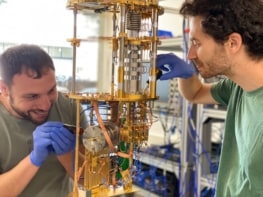Materials with a negative refractive index do not violate the laws of physics according to a series of recent experiments and computer simulations. First proposed in 1968, these materials - which bend light in the opposite direction to conventional materials, and which are also known as left-handed materials - were only demonstrated in experiments for the first time in 2000. However, some physicists argued that although the phase velocity of the light was negatively refracted, the group velocity was not. Others claimed that negative refraction violated causality by permitting velocities greater than the speed of light. Several experiments and simulations have now demonstrated that negative refraction is real and that causality is not violated.
Costas Soukoulis and colleagues at Iowa State University in the US and the FORTH laboratory in Greece performed computer simulations on a left-handed photonic crystal to show that causality remains intact in such materials (S Foteinopoulou et al. 2003 Phys. Rev. Lett. 90 107402).
The researchers solved Maxwell’s equations to study how an electromagnetic wave evolves in time as it hits the surface of a negative-index material. They saw that the incoming beam was refracted in the negative direction – as expected – but they also noticed that this refraction did not occur straight away. Instead, the whole wave front was temporarily trapped in the surface region. Soukoulis and colleagues argue that the delays caused by this trapping explain how the outer rays in the beam appear to travel faster than the velocity of light.
“These calculations are an important confirmation that the speed of light is not violated by negative refraction,” John Pendry, a theorist at Imperial College in London who did much of the early work on negative-index materials, told PhysicsWeb. “It is time to move on and start making use of these amazing new materials.”
Further experiments and simulations confirming the existence of negative-index materials have been performed by Claudio Parazzoli and co-workers at the Boeing Phantom Works in Seattle (Phys. Rev. Lett. 90 107401), and by Andrew Houck and colleagues at Harvard University and the Massachusetts Institute of Technology (Phys. Rev. Lett. to be published).



